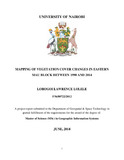| dc.description.abstract | Over the last decade, the forests of the Mau Complex have been heavily impacted by official
forest excisions, as well as by illegal, irregular and unplanned settlements. Eastern Mau Forest
reserve is one of the most affected forest blocks. Eastern Mau complex and the whole of the Mau
ecosystem is a critical catchment areas, key to major conservation areas, key to people’s
livelihood and is a major micro-climate regulator in the Rift Valley region and in the country at
large.
This project examines the use of GIS and Remote Sensing in mapping land use land cover in
East Mau Complex between 1990 and 2014 so as to detect the changes that have taken place in
forest cover between these periods. In achieving this, Landsat images of the years in focus and
relevant geographical information were obtained and used. Remote sensing and GIS based
applications were used to analyze and derive information from the data collected.
The result of the work showed areas where vegetation hotspots are most prevalent, vegetation
cover changes and the quantification of various land use classes between 1990 and 2014 (Ref.
Table 4.1)
Suggestions were therefore made at the end of the work on ways to use the information as
contained therein optimally. This study will help to increase forest cover, to protect critical
catchment areas, to rationalize land use in excised forest areas, to realign gazette forest
boundaries and to reduce forest fragmentation | en_US |

